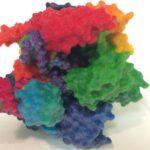 Classic galactosemia is a rare inborn error of carbohydrate metabolism, caused by a severe deficiency of the enzyme galactose-1-phosphate uridylyltransferase (GALT). A galactose-restricted diet has proven to be very effective to treat the neonatal life-threatening manifestations and has been the cornerstone of treatment for this severe disease. However, burdensome complications occur despite a lifelong diet. For rare diseases, a patient disease specific registry is fundamental to monitor the lifespan pathology and to evaluate the safety and efficacy of potential therapies. In 2014, the international Galactosemias Network (GalNet) developed a web-based patient registry for this disease, the GalNet Registry. The aim was to delineate the natural history of classic galactosemia based on a large dataset of patients. Observational data derived from 15 countries and 32 centers including 509 patients were acquired between December 2014 and July 2018. Most affected patients experienced neonatal manifestations (79.8%) and despite following a diet developed brain impairments (85.0%), primary ovarian insufficiency (79.7%) and a diminished bone mineral density (26.5%). Newborn screening, age at onset of dietary treatment, strictness of the galactose-restricted diet, p.Gln188Arg mutation and GALT enzyme activity influenced the clinical picture. Detection by newborn screening and commencement of diet in the first week of life were associated with a more favorable outcome. A homozygous p.Gln188Arg mutation, GALT enzyme activity of ≤ 1% and strict galactose restriction were associated with a less favorable outcome. For more information click here.
Classic galactosemia is a rare inborn error of carbohydrate metabolism, caused by a severe deficiency of the enzyme galactose-1-phosphate uridylyltransferase (GALT). A galactose-restricted diet has proven to be very effective to treat the neonatal life-threatening manifestations and has been the cornerstone of treatment for this severe disease. However, burdensome complications occur despite a lifelong diet. For rare diseases, a patient disease specific registry is fundamental to monitor the lifespan pathology and to evaluate the safety and efficacy of potential therapies. In 2014, the international Galactosemias Network (GalNet) developed a web-based patient registry for this disease, the GalNet Registry. The aim was to delineate the natural history of classic galactosemia based on a large dataset of patients. Observational data derived from 15 countries and 32 centers including 509 patients were acquired between December 2014 and July 2018. Most affected patients experienced neonatal manifestations (79.8%) and despite following a diet developed brain impairments (85.0%), primary ovarian insufficiency (79.7%) and a diminished bone mineral density (26.5%). Newborn screening, age at onset of dietary treatment, strictness of the galactose-restricted diet, p.Gln188Arg mutation and GALT enzyme activity influenced the clinical picture. Detection by newborn screening and commencement of diet in the first week of life were associated with a more favorable outcome. A homozygous p.Gln188Arg mutation, GALT enzyme activity of ≤ 1% and strict galactose restriction were associated with a less favorable outcome. For more information click here.
Featured posts
 Acromegaly is a rare disease with vocal changes being a common clinical finding. The authors present a very rare case of an opera singer with undetected acromegaly for years, whose tessiture progressively changed from tenor, to baritone, to bass. We analyze the evolution of vocal parameters over the years and the outcome after surgical treatment. For more information click here.
Acromegaly is a rare disease with vocal changes being a common clinical finding. The authors present a very rare case of an opera singer with undetected acromegaly for years, whose tessiture progressively changed from tenor, to baritone, to bass. We analyze the evolution of vocal parameters over the years and the outcome after surgical treatment. For more information click here.
Neural tube defects (NTD’s) represent a group of severe congenital abnormalities that are associated with high mortality, adverse outcomes and long-term disabilities, as well as significant emotional, psychological and economic consequences. Every year, approximately 5 000 cases of NTD’s occur in the EU. Most of them are diagnosed prenatally with subsequent termination of pregnancy. Preconceptual intake of folic acid has been found to significantly reduce the risk for NTD’s. Nevertheless, to date, there are no folic acid programs available in European countries for women in reproductive age or, in particular, for those who are planning a pregnancy. The publication aims to present and analyze new trends in the use of folic acid as a primary prevention of rare genetic diseases. For more information click here.
Synonym(s):Epilepsy-dementia-amelogenesis imperfecta syndrome
Kohlschutter-Tonz syndrome
ICD-10: G40.8
ORPHANET number: ORPHA1946
For more information about this disease, please visit the Orphanet website.
Visitors from North America may also contact NIH Office of Rare Diseases Research website.
—————————————————————————
Last modification: 12:40 21.05.2024
—————————————————————————
 The team of the Institute for Rare Diseases has published a new scientific study. The aim of the study is to analyze the views of Bulgarian oncologists and hematologists regarding the value of innovative pharmaceutical treatments in their clinical area. Physicians were invited to review a life-prolonging scenario and to indicate what minimum improvement in median survival a new treatment would have to generate for them to recommend it over the standard of care. Respondents were also asked to state the highest cost at which they would recommend a new therapy that would improve patient’s health-related quality of life (HRQoL) but would have no impact on survival. In addition, physicians were asked whether they would consider different responses under certain circumstances. Responses were used to calculate incremental cost-effectiveness ratios (ICERs) for each scenario. They found a high willingness-to-pay for innovative drugs in oncology and hematology. The wide range of responses observed, however, indirectly implies a lack of consensus on the use of explicit ICER thresholds in Bulgaria. For more information click here.
The team of the Institute for Rare Diseases has published a new scientific study. The aim of the study is to analyze the views of Bulgarian oncologists and hematologists regarding the value of innovative pharmaceutical treatments in their clinical area. Physicians were invited to review a life-prolonging scenario and to indicate what minimum improvement in median survival a new treatment would have to generate for them to recommend it over the standard of care. Respondents were also asked to state the highest cost at which they would recommend a new therapy that would improve patient’s health-related quality of life (HRQoL) but would have no impact on survival. In addition, physicians were asked whether they would consider different responses under certain circumstances. Responses were used to calculate incremental cost-effectiveness ratios (ICERs) for each scenario. They found a high willingness-to-pay for innovative drugs in oncology and hematology. The wide range of responses observed, however, indirectly implies a lack of consensus on the use of explicit ICER thresholds in Bulgaria. For more information click here.
 The European Union defines a disease as rare when it affects fewer than 5 per 10 000 persons, whereas the USA considers a condition rare if it affects fewer than 200 000 individuals. To date, however, there is no terminology to appropriately address these diseases as a category other than rare diseases, or in some instances orphan diseases when referring to conditions that lack the resources for treatment discovery. For more information click here.
The European Union defines a disease as rare when it affects fewer than 5 per 10 000 persons, whereas the USA considers a condition rare if it affects fewer than 200 000 individuals. To date, however, there is no terminology to appropriately address these diseases as a category other than rare diseases, or in some instances orphan diseases when referring to conditions that lack the resources for treatment discovery. For more information click here.
 “I have HAE. I’ll be stronger with your support” is the motto of this year’s international HAE day in Bulgaria, organized by the association HAE and celebrated on the 16th of May. All the members of the organization call for support the society, families and friends of the patients. As a support, the municipality of Plovdiv joined the event and have illuminated the building of the central municipality in blue. The event is organized together with the National Alliance of People with Rare Diseases, Mr. Georgi Tityukov (Mayor of Social Policy and Sport – Plovdiv), Institute for Rare Diseases, Profesional School of Food Technology and Technologies – Plovdiv and others.
“I have HAE. I’ll be stronger with your support” is the motto of this year’s international HAE day in Bulgaria, organized by the association HAE and celebrated on the 16th of May. All the members of the organization call for support the society, families and friends of the patients. As a support, the municipality of Plovdiv joined the event and have illuminated the building of the central municipality in blue. The event is organized together with the National Alliance of People with Rare Diseases, Mr. Georgi Tityukov (Mayor of Social Policy and Sport – Plovdiv), Institute for Rare Diseases, Profesional School of Food Technology and Technologies – Plovdiv and others.
 Rosai-Dorfman disease (RDD) with isolated central nervous system (CNS) involvement is an extremely rare disease. Most RDD of the CNS present as dural-based mass mimicking meningioma and other common lesions, which makes preoperative accurate diagnosis of great difficulty. We searched the pathology database in our hospital and 3 cases of RDD with isolated CNS involvement were finally included in our study. Radiological and clinical findings of these three cases were retrospectively analyzed. The lesions of 2 cases were dura-based against the cerebral convexity, presenting as a sheet-shaped thickened dura mater, another case was located just across the cerebral falx, the dural display in the center was intact. The 3 cases showed low signal intensity on T2-weighted image, obviously enhanced, significantly surrounding edema and finger-like protuberance but no invasion of the brain parenchyma or no sign of hyperplasia or sclerosis of the surrounding cranial bones. In conclusion, when we come across a disease that mimicking meningioma, especially when it manifests as the above radiological features, we should considered it might be a kind of proliferative disease of the meninges, such as RDD. For more information click here.
Rosai-Dorfman disease (RDD) with isolated central nervous system (CNS) involvement is an extremely rare disease. Most RDD of the CNS present as dural-based mass mimicking meningioma and other common lesions, which makes preoperative accurate diagnosis of great difficulty. We searched the pathology database in our hospital and 3 cases of RDD with isolated CNS involvement were finally included in our study. Radiological and clinical findings of these three cases were retrospectively analyzed. The lesions of 2 cases were dura-based against the cerebral convexity, presenting as a sheet-shaped thickened dura mater, another case was located just across the cerebral falx, the dural display in the center was intact. The 3 cases showed low signal intensity on T2-weighted image, obviously enhanced, significantly surrounding edema and finger-like protuberance but no invasion of the brain parenchyma or no sign of hyperplasia or sclerosis of the surrounding cranial bones. In conclusion, when we come across a disease that mimicking meningioma, especially when it manifests as the above radiological features, we should considered it might be a kind of proliferative disease of the meninges, such as RDD. For more information click here.
 An international meeting in support of the patients with acute porphyria will be held in Sofia on 06.06.2019 in the National Center of Public Health and Analyses from 13:00-17:00. Participants in the event will be patients with porphyria and their families, medical students and interns, general practitioners from the country and other medical specialist from the National Alliance of People with Rare Diseases (NAPRD). The participation of the event is free of charge but you need to register before 30.05.2019. For more information open the program of the event.
An international meeting in support of the patients with acute porphyria will be held in Sofia on 06.06.2019 in the National Center of Public Health and Analyses from 13:00-17:00. Participants in the event will be patients with porphyria and their families, medical students and interns, general practitioners from the country and other medical specialist from the National Alliance of People with Rare Diseases (NAPRD). The participation of the event is free of charge but you need to register before 30.05.2019. For more information open the program of the event.

